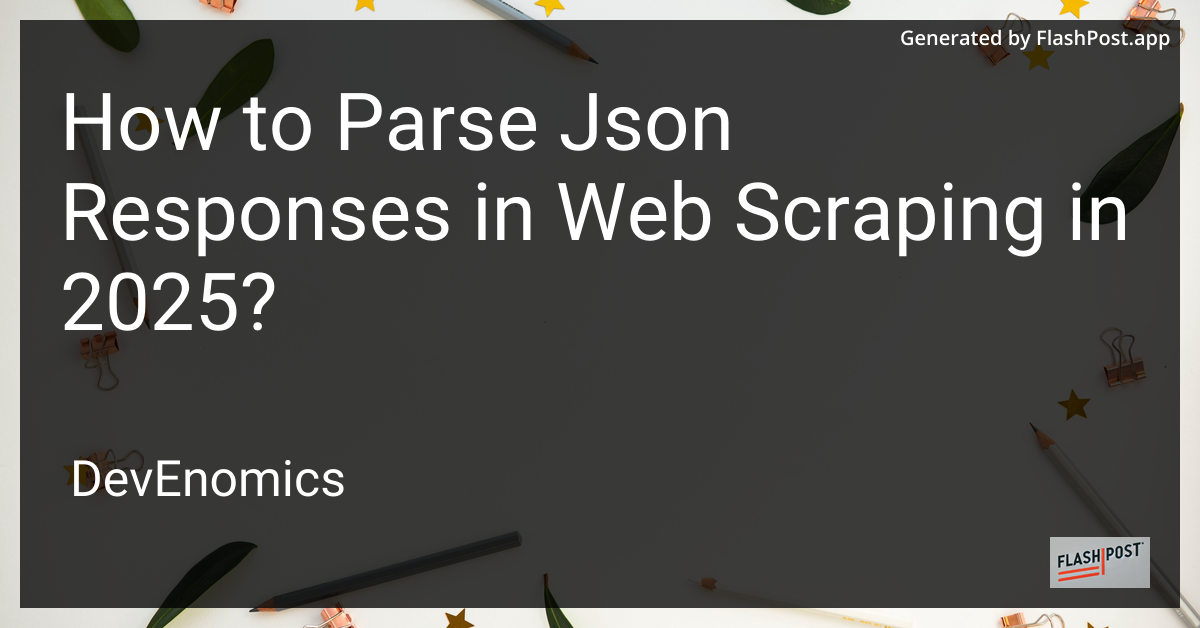

How to Parse Json Responses in Web Scraping in 2025?
In the ever-evolving landscape of web scraping, staying up-to-date with the latest techniques is crucial for success. One of the most critical aspects of modern web scraping is effectively parsing JSON responses. As of 2025, JSON remains a popular data interchange format due to its lightweight and easy-to-understand structure. This article will guide you through the process of parsing JSON responses when web scraping, ensuring your data extraction pipeline remains accurate and efficient.
Understanding JSON in Web Scraping
JSON (JavaScript Object Notation) is a text-based data format that is human-readable and widely used to transmit data between a server and web application. When scraping the web, especially APIs, JSON is commonly encountered. Learning to parse JSON effectively can help to extract data more systematically, speeding up your web scraping projects.
Tools and Libraries for Parsing JSON in 2025
Several powerful libraries and tools can help you parse JSON in various programming languages. Below are some popular ones in 2025:
- Python:
json(built-in module),requestswith built-in JSON parsing,pandasfor more complex data structures. - JavaScript/Node.js: Use the
fetchAPI for HTTP requests and the built-inJSONobject for parsing. - Java: Libraries like
JacksonorGson. - Ruby: The
JSONmodule which is typically built-in with Ruby installations.
Step-by-Step JSON Parsing in Web Scraping
Let’s delve into parsing JSON responses in a typical web scraping task using Python, one of the most popular languages for web scraping due to its simplicity and robust library support.
1. Setup Your Environment
Ensure you have Python installed along with libraries like requests for making HTTP requests.
pip install requests2. Making an HTTP Request
Begin by making an HTTP request to the URL you wish to scrape. Here’s a simple example using requests.
import requests
response = requests.get('https://api.example.com/data')3. Accessing JSON Data
Assuming the server responds with JSON, you can convert the response into a Python dictionary using the json() method.
data = response.json()4. Extracting Required Information
You can now navigate through the dictionary to extract the specific data you need.
for item in data['items']:
print(item['name'], item['value'])5. Handling JSON Parsing Exceptions
It’s vital to handle potential exceptions during the parsing process to ensure robustness.
try:
data = response.json()
except ValueError as e: # includes simplejson.decoder.JSONDecodeError
print("Error parsing JSON:", e)Best Practices for JSON Parsing in Web Scraping
- Error Handling: Always implement try-except blocks when dealing with JSON data to gracefully handle any issues that arise from unexpected data formats.
- Data Validation: Validate the parsed data to ensure it meets your application’s needs.
- Rate Limiting: Be mindful of the API’s rate limits and implement appropriate error handling mechanisms.
Enhance Your Scraping with Proxies
Using proxies can assist in circumventing geo-restrictions and IP bans often encountered in web scraping. For more insights, consider exploring these resources on top twitter proxy services 2025 and best proxy for twitter.
Additionally, understanding proxy effectiveness is key, especially for platforms like Craigslist, as discussed in this craigslist proxy testing guide.
Conclusion
As web scraping continues to grow in 2025, being adept at parsing JSON responses will enhance your data automation tasks. Using the right tools and techniques ensures that you can handle the wealth of information available via JSON formatted data effectively. Remember to stay informed on proxy usage and effectiveness to maintain seamless web scraping operations.
This markdown article is crafted to be SEO optimized for the topic of JSON parsing in web scraping, links are incorporated to improve leverage of proxy resources.